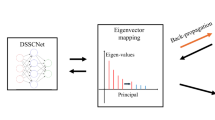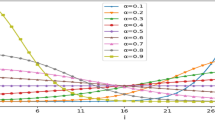Abstract
Exploring the multiple subspace structures of data such as low-rank representation is effective in subspace clustering. Non-convex low-rank representation (NLRR) via matrix factorization is one of the state-of-the-art techniques for subspace clustering. However, NLRR cannot scale to problems with large n (number of samples) as it requires either the inversion of an \(n\times n\) matrix or solving an \(n\times n\) linear system. To address this issue, we propose a novel approach, NLRR++, which reformulates NLRR as a sum of rank-one components, and apply a column-wise block coordinate descent to update each component iteratively. NLRR++ reduces the time complexity per iteration from \({\mathcal {O}}(n^3)\) to \({\mathcal {O}}(mnd)\) and the memory complexity from \({\mathcal {O}}(n^2)\) to \({\mathcal {O}} (mn)\), where m is the dimensionality and d is the target rank (usually \(d\ll m\ll n\)). Our experimental results on simulations and real datasets have shown the efficiency and effectiveness of NLRR++. We demonstrate that NLRR++ is not only much faster than NLRR, but also scalable to large datasets such as the ImageNet dataset with 120K samples.



Similar content being viewed by others
Notes
\(({\mathbf {A}}+\mathbf {UCV})^{-1}={\mathbf {A}}^{-1}-{\mathbf {A}}^{-1}{\mathbf {U}}(\mathbf {C}^{-1}+\mathbf {V}{\mathbf {A}}^{-1}{\mathbf {U}})^{-1}\mathbf {V}{\mathbf {A}}^{-1}\).
Our source code is available at https://github.com/junwang929/subspace-clustering.
References
Amin F, Fahmi A, Abdullah S (2019) Dealer using a new trapezoidal cubic hesitant fuzzy topsis method and application to group decision-making program. Soft Comput 23:5353–5366
Bertsekas DP (1999) Nonlinear programming. Athena scientific, Belmont
Bian W, Ding S, Yu X (2017) An improved fingerprint orientation field extraction method based on quality grading scheme. Int J Mach Learn Cybern 9(8):1–12
Burer S, Monteiro RDC (2005) Local minima and convergence in low-rank semidefinite programming. Math Program 103(3):427–444
Cheng D, Nguyen MN, Gao J, Shi D (2013) On the construction of the relevance vector machine based on bayesian ying-yang harmony learning. Neural Netw 48(6):173–179
Ding S, Xu X, Fan S (2018) Locally adaptive multiple kernel k-means algorithm based on shared nearest neighbors. Soft Comput 22:4573–4583
Du M, Ding S, Jia H (2016) Study on density peaks clustering based on k-nearest neighbors and principal component analysis. Knowl Based Syst 99:135–145
Du M, Ding S, Yu X (2017) A novel density peaks clustering algorithm for mixed data. Pattern Recognit Lett 97:46–53
Du M, Ding S, Yu X, Shi Z (2018) A novel density peaks clustering with sensitivity of local density and density-adaptive metric. Knowl Inf Syst 1:1–25
Elhamifar E, Vidal R (2013) Sparse subspace clustering: algorithm, theory, and applications. IEEE Trans Pattern Anal Mach Intell 35(11):2765–2781
Fahmi A, Abdullah S, Amin F, Khan MSA (2019) Trapezoidal cubic fuzzy number Einstein hybrid weighted averaging operators and its application to decision making. Soft Comput 23:5753–5783
Fan S, Ding S, Yu X (2016) Self-adaptive kernel k-means algorithm based on the shuffled frog leaping algorithm. Soft Comput 22(3):1–12
Fazel M, Hindi H, Boyd SP (2001) A rank minimization heuristic with application to minimum order system approximation. In: American control conference, vol 6. IEEE, pp 4734–4739
Feng J, Xu H, Yan S (2013) Online robust PCA via stochastic optimization. In: Advances in neural information processing systems, vol 26, pp 404–412
Hale ET, Yin W, Zhang Y (2008) Fixed-point continuation for l1 minimization: methodology and convergence. SIAM J Optim 19(3):1107–1130
Jia H, Ding S, Du M (2017) A nystrom spectral clustering algorithm based on probability incremental sampling. Soft Comput 21:5815–5827
Krizhevsky A, Sutskever I, Hinton GE (2012) Imagenet classification with deep convolutional neural networks. In: Advances in neural information processing systems, vol 25, no 2, pp 1097–1105
Larsen B, Aone C (1999) Fast and effective text mining using linear-time document clustering. In: Proceedings of the fifth ACM SIGKDD international conference on Knowledge discovery and data mining. ACM, pp 16-22
Liu G, Lin Z, Yan S, Sun J, Yu Y, Ma Y (2013) Robust recovery of subspace structures by low-rank representation. IEEE Trans Pattern Anal Mach Intell 35(1):171–184
Lu C, Feng J, Lin Z, Yan S (2014) Correlation adaptive subspace segmentation by trace lasso. In: IEEE international conference on computer vision
Ng AY, Jordan MI, Weiss Y et al (2001) On spectral clustering: analysis and an algorithm. NIPS 14(2):849–856
Recht B, Fazel M, Parrilo PA (2010) Guaranteed minimum-rank solutions of linear matrix equations via nuclear norm minimization. SIAM Rev 52(3):471–501
Richtrik P, Tak M (2014) Iteration complexity of randomized block-coordinate descent methods for minimizing a composite function. Math Program 144:1–38
Shen J, Li P (2016) Learning structured low-rank representation via matrix factorization. In: Proceedings of the 19th international conference on artificial intelligence and statistics (AISTATS), pp 500–509
Shen J, Li P, Xu H (2016) Online low-rank subspace clustering by basis dictionary pursuit. In: Proceedings of the 33rd international conference on machine learning (ICML), pp 622–631
Tang X, Wei G (2019) Multiple attribute decision-making with dual hesitant pythagorean fuzzy information. Cogn Comput 11(2):193–211
Tang X, Wei G, Gao H (2019) Models for multiple attribute decision making with interval-valued pythagorean fuzzy muirhead mean operators and their application to green suppliers selection. Informatica 30(1):153–186
Von Luxburg U (2007) A tutorial on spectral clustering. Stat Comput 17(4):395–416
Wall ME, Rechtsteiner A, Rocha LM (2003) Singular value decomposition and principal component analysis. In: Berrar DP, Dubitzky W, Granzow M (eds) A practical approach to microarray data analysis. Springer, Boston, MA, pp 91–109
Wang J, Shi D, Cheng D, Zhang Y, Gao J (2016) LRSR: low-rank-sparse representation for subspace clustering. Neurocomputing 214:S0925231216307573
Wang L, Peng JJ, Wang JQ (2018) A multi-criteria decision-making framework for risk ranking of energy performance contracting project under picture fuzzy environment. J Clean Prod 191:105–118
Wang R, Wang J, Gao H, Wei G (2019) Methods for madm with picture fuzzy muirhead mean operators and their application for evaluating the financial investment risk. Symmetry 11(6):1–21
Yu H-F, Hsieh C-J, Si S, Dhillon I (2012) Scalable coordinate descent approaches to parallel matrix factorization for recommender systems. In: IEEE 12th international conference on data mining (ICDM). IEEE, pp 765–774
Zhang S, Gao H, Wei G, Wei Y, Wei C (2019) Evaluation based on distance from average solution method for multiple criteria group decision making under picture 2-tuple linguistic environment. Mathematics 7(3):1–14
Zhou X, Yang C, Yu W (2013) Moving object detection by detecting contiguous outliers in the low-rank representation. IEEE Trans Pattern Anal Mach Intell 35(3):597–610
Acknowledgements
This research was supported by the National Natural Science Foundation of China (Grant No. 51677042, 61402133).
Author information
Authors and Affiliations
Corresponding author
Ethics declarations
Conflict of interest
All author declares that he/she has no conflict of interest.
Ethical approval
This article does not contain any studies with human participants or animals performed by any of the authors.
Additional information
Communicated by V. Loia.
Publisher's Note
Springer Nature remains neutral with regard to jurisdictional claims in published maps and institutional affiliations.
Rights and permissions
About this article
Cite this article
Liu, X., Wang, J., Cheng, D. et al. Non-convex low-rank representation combined with rank-one matrix sum for subspace clustering. Soft Comput 24, 15317–15326 (2020). https://doi.org/10.1007/s00500-020-04865-0
Published:
Issue Date:
DOI: https://doi.org/10.1007/s00500-020-04865-0




